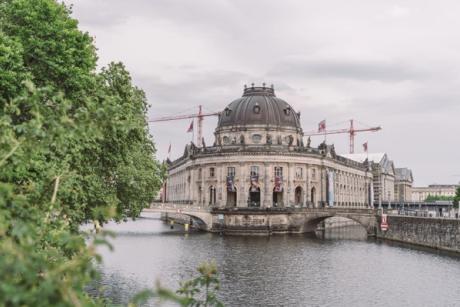The Ballad of Special Ops Cody
2017 - Film & Video (Film & Video)
20:00 minutes
Michael Rakowitz
The Ballad of Special Ops Cody by Michael Rakowitz is a serio-comic stop motion animated film in which an everyday African-American G. I. character, personified through an action figure that comes to life. The protagonist breaks into Chicago’s Oriental Institute to “liberate” Mesopotamian votive statues, who are likewise animated through voice-over narration, from their imprisonment in the museum’s vitrines. This set-up allows for meditations on various war and colonial histories; as a barbed twist on the Bush-era rhetoric of promoting “democracy” in the Middle East through regime change, the G. I. cannot understand why the statues wish to remain in the museum and not return to their (currently war torn) “homelands”. The particular proxy of “Cody” is no accident; in 2005 an alleged Mujahideen group released a video in which they claimed to have captured an US soldier who they would behead if the US didn’t release a demanded set of prisoners in 72 hours. As it turned out, this ransom was a hoax; a 20-year old independent Iraqi citizen used various special effects to make it look as if a “Special Ops Cody” doll was the detainee in question. These dolls were readily available in Iraq as they were marketed to local children as surrogates for parents fighting the war. Like the rest of Rakowitz’s practice, The Ballad of Special Ops Cody riddles a complex discourse on war but also on the complicated diplomatic issues of representation and repatriation.
Michael Rakowitz uses the novel charm of everyday things to excite new and oblique approaches to loaded geopolitical subject matter. This is most evident in his delicate reworking of food packaging, such as those found to wrap dates of Middle Eastern origin, into replica assemblages of ancient Mesopotamian artifacts that are both under threat by client-statist wars and the looting that occurs in their wake. Beyond his practice, Rakowitz is known as an artist of great integrity who practices what he preaches; the artist withdrew from the Whitney Biennale as a form of protest against the museums Vice Chairman who owns a private security firm which was implicated in tear gassing “alien” asylum seekers at the US border. Instead of marginalizing foreign cultures through the rhetorical misrepresentation of who they are and what they stand for, Rakowitz brings disparate people together through wry political scenarios that defamiliarize glib stereotypes. For example, in his Enemy Kitchen project, American school children learn how to cook and share Iraqi food as a way to introduce alternative discourses about a “demonized” population.
Colors:
Related works sharing similar palette

© » KADIST
Elisheva Biernoff
2009In her recent work, Biernoff is interested in investigating fictions and fantasies embedded in the remnants of consumer culture (for example magazines) or through ephemera such as postcards and old photographs...

© » KADIST
Edgar Arceneaux
2006Untitled (Wheelchair Drawing) is a ten-foot photo transfer of the image of a wheelchair with burning embers in its seat...

© » KADIST
Lim Sokchanlina
2017The photographic series Wrapped Future II by Lim Sokchanlina brings fences used on construction sites to enclose the surrounding areas, to different locations, lakes, valleys and forests; and places them at the center of works to obscure the beautiful Cambodian landscape...

© » THEARTNEWSPER
Berlin’s state museums raise ticket prices as costs climb Art market Museums & heritage Exhibitions Books Podcasts Columns Technology Adventures with Van Gogh Search Search Museums & Heritage news Berlin’s state museums raise ticket prices as costs climb “We have to increase income and reduce spending,” says Hermann Parzinger, the president of the Prussian Cultural Heritage Foundation Catherine Hickley 14 December 2023 Share Tickets to Berlin's Bode Museum will increase from €10 to €12 © Fi onn Große Admission to Berlin’s state museums will increase next year to cover rising costs, the Prussian Cultural Heritage Foundation has announced...

© » KADIST
Phan Thao Nguyên
2013On September 22, 1940 the French signed an accord, which granted Japanese troops the right to occupy Indochina...

© » DAZED DIGITAL
Taylor Swift deepfake porn is the tip of the AI iceberg | Dazed â¬…ï¸ Left Arrow *ï¸âƒ£ Asterisk â Star Option Sliders âœ‰ï¸ Mail Exit Life & Culture Feature The recent wave of AI-generated celebrity porn highlights the harmful role of text-to-image models in enabling image-based sexual abuse 12 February 2024 Text Brit Dawson For those who’ve been keeping track of the ever-advancing abuse of deepfake technology, the story sadly came as no surprise...

© » ARTFORUM
Details for First-Ever Malta Biennale Announced – Artforum Read Next: ARGENTINIAN PRESIDENT JAVIER MILEI SHUTTERS MINISTRY OF CULTURE Subscribe Search Icon Search Icon Search for: Search Icon Search for: Follow Us facebook twitter instagram youtube Alerts & Newsletters Email address to subscribe to newsletter...

© » ARTS EQUATOR
The working processes of artists: NADA | ArtsEquator Thinking and Talking about Arts and Culture in Southeast Asia Articles June 22, 2020 Artists Rizman Putra and Safuan Johari of the duo NADA talk about the evolution of their artistic practice, from being a fictional band at the Malay Heritage Centre to becoming an international art/music juggernaut...












